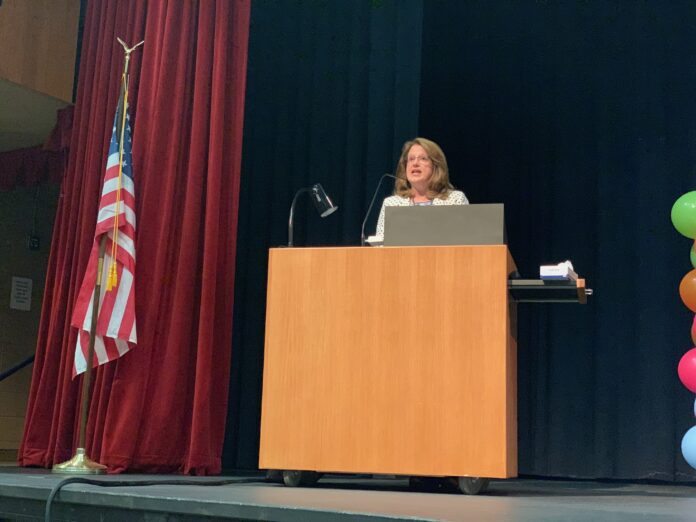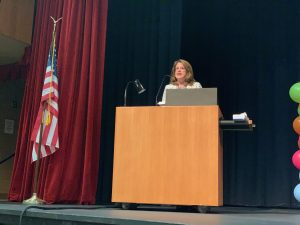
By Hayden Seder

As schools Valley-wide prep for the start of a new school year, staff across the Blaine County School District attended an Aug. 13 meeting that featured Luis Cruz, a 30-year teacher and administrator who co-authored Time for Change, which examines how schools can better close the student achievement gap experienced, just about, everywhere.
The “achievement gap” refers to the disconnect in student performance between the five student subgroups: white, Hispanic, Limited English Proficient (LEP), economically disadvantaged, and students with disabilities. There are 3,467 students in the district pre-kindergarten through 12th grade and the district has the job of ensuring that resources are allocated appropriately to each of these subgroups to ensure that all students succeed.
Concerns have been raised within the school district, particularly by parents and I-CARE (Idaho Citizens for Accountable, Responsible Education) that the district is not doing enough to close this divide.
“I would hope there’s concern about it because our charge as given by the State of Idaho and our Board of Trustees is to ensure all of our students master the state standards and go beyond,” said district superintendent GwenCarol Holmes.
Holmes describes a “perfect storm” of issues in the school district that creates the achievement gap. Among them, new rigorous standards from the state combined with demographics that include much more poverty and more diversity in ethnicity and race. Holmes said another factor in the mix is a change in what is expected of educators.
“It used to be expected that I taught the content or curriculum,” Holmes said. “Now it’s expected that I ensure that every child learn; there’s a difference between teaching and learning.”
Another ingredient in the storm is a tight budget, meaning the district can’t spend its way out of the achievement gap problem.
Nonetheless, Holmes and teachers within the district have taken certain measures to help bridge the gap, including how resources are budgeted (for needs of students versus equally across subgroups), more investment in English as New Language (ENL) teachers, and investment in teachers getting ENL certifications.
A major contributor to the achievement gap, Holmes acknowledges, is due to those who speak English as a first language. This is in large part due to changing demographics. In the 2000-01 school year, 86 percent of students were white and 13 percent Hispanic, compared to the now 54 percent of enrolled white students and 42 percent Hispanic. According to a recent article in IdahoEdNews, 39 percent of Latino students in Idaho in grades K-3 read below grade level compared to 19 percent of white students and only 24 percent of Latino students in Idaho scored proficient in math on 2018 standardized tests compared to nearly half of white students scoring proficient or above at 49 percent.
A number of teachers have completed the ENL certification process or are in the process, including Wood River High School social studies teacher Maritt Wolfrom, who was instrumental in bringing Cruz to the Valley after seeing him speak several years ago at a conference.
“Luis is charismatic and inspiring and has worked at a variety of schools in California,” Wolfrom said. “He challenges you to be reflective in your practices and to look at your procedures and policies. He makes you ask, ‘Are we perpetuating any sort of stereotypes or racism? Are the things we’re doing hindering or helping students?’”
Wolfrom came back from her original meeting with Cruz inspired but overwhelmed, determined to spread his message to the rest of the district.
At Cruz’s presentation to the district—titled “How Can We Collectively Create School Cultures that Eliminate Gaps?”—he began by explaining how he got into education and then delved into the problem of explaining the teaching profession and its difficulties to those not in the profession. Wolfrom and Holmes agree that many in the district who criticize efforts made to close achievement gaps are unaware of the difficulties present and the efforts being made.
The main message of Cruz’s talk is that schools need to ensure that all students get what’s needed to succeed at high levels (i.e., grade level or higher). To do that, current educational systems never designed to benefit all students need to be redesigned by changing policies, practices, procedures, and mindsets. Policies and procedures need to be equitable, not equal, in order to help the students that need help the most, such as Spanish-speaking or students stuck in the poverty cycle.
“There was a time when kids could be successful with a couple skills during an agricultural and industrial economy,” Cruz said. “We didn’t need critical thinkers but people who could provide labor. Society has changed to a global/information economy. Every child that walks into your classroom, into your office, into your school, has to learn at high levels today.”


